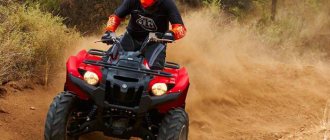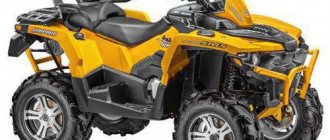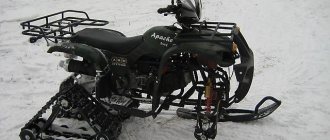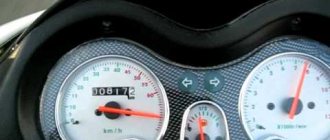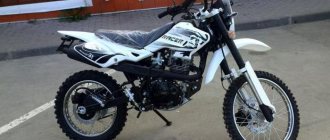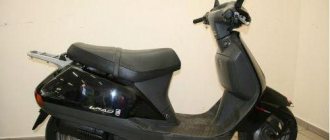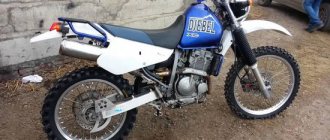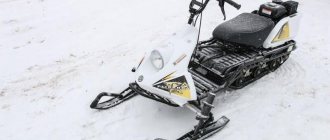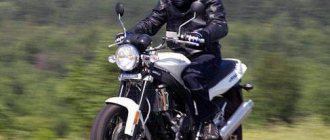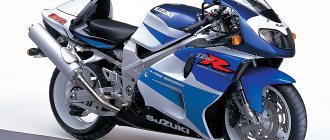The Yamaha Grizzly 125 model is a small-capacity utilitarian ATV with rear-wheel drive. Thanks to its many advantages, this ATV can be used for learning to ride a four-wheeled type of motor vehicle, since its control is quite simple and understandable.
The design of this model was simplified as much as possible, which in turn had a positive effect on reliability. The Yamaha Grizzly 125 has a single-cylinder power plant with a displacement of 125 cubic meters, which is exactly what is indicated in the model index. The torque from the engine is transmitted by an automatic transmission system with a chain to the rear axle. The fuel system includes a carburetor manufactured by Mikuni. The engine is started using an electric starter. The ATV has drum brakes located on both axles.
The model differs from most of its analogues in its high maneuverability and low weight, which together significantly expands the capabilities of the equipment when moving over various terrains. The Yamaha Grizzly 125 ATV is controlled by a single lever and handles located on the steering wheel. The cladding elements are made of high-quality, impact-resistant plastic. There are also special protective arches for luggage racks.
The key advantages of the Yamaha Grizzly 125 ATV include the following:
- Simple and intuitive controls.
- Simple design and separate mechanisms.
- Availability of forward, reverse and neutral gears.
- Compact overall dimensions, which allows you to transport the ATV without much difficulty.
- High reliability and minimal maintenance requirements.
- Electric starter start of the power unit.
- Relatively small weight in running order.
- Availability of fully automatic V-belt transmission of torque from the engine.
- The presence of wide wings with integrated floor panels.
- The parking brake is in the form of a lever located on the steering wheel.
- Sealed drum brakes.
Specifications
Power point:
- Number of cylinders - 1.
- The cylinder diameter is 49 millimeters.
- The piston stroke is 66 millimeters.
- Working volume - 125 cubic meters.
- Rated output power is 8.6 horsepower.
- Number of valves - 2.
- Number of camshafts - 1.
- The camshaft location is overhead (SOHC).
- Cooling system type: air.
- Type of lubrication system - oil bath.
- Fuel system type: carburetor (Mikuni).
- Ignition system type - DC-CDI.
- Starting system type: electric starter.
- Transmission system type: automatic with V-belt drive.
Chassis:
- Drive type - 2WD.
- Front suspension type: independent with single A-arm.
- Rear suspension type: pendulum arm.
- The front suspension travel is 70 millimeters.
- Rear suspension travel is 80 millimeters.
- Front tires - AT20x7-8.
- Rear tires - AT22x10-8.
- Front brake type: double drum, sealed.
- Rear brake type: drum, sealed.
Dimensions:
- Structural length - 1700 millimeters.
- The structural width is 990 millimeters.
- The structural height is 980 millimeters.
- Wheelbase length -1080 millimeters.
- The lowest ground clearance is 145 millimeters.
Capacity volume:
The capacity of the fuel tank is 7 liters.
Load capacity:
The maximum weight of cargo transported on the front trunk is 5 kilograms. The maximum weight of cargo transported on the rear trunk is 10 kilograms.
Operating experience
Owners of the Yamaha 125 ATV appreciated its driving performance and reliability. Of course, the equipment is not designed for driving on difficult routes, but on an ordinary road it handles confidently.
Advantages of Grizzly:
- Reliability. When buying a new Grizzly 125, you can be sure that the device will work without breakdowns for more than one year. With regular maintenance, the car will last 4-5 years.
- Availability of automatic transmission. Thanks to the transmission, even beginners can use the equipment. The easy-to-use device is perfect for children and teenagers.
- Load capacity. The miniature machine can withstand loads of up to 150 kg.
- Soft suspension. Small holes and bumps are practically not felt when driving.
- Excellent traction. Grizzly confidently climbs the hills.
- Simple design.
- Economical. On average, a car spends 2-2.5 liters of gasoline per 100 km.
The Yamaha 125 ATV also has several minor disadvantages:
- Slightly overpriced. A used car from 2005 costs around 60-75 thousand rubles. A more recent version will cost 90-140 thousand rubles.
- Problems finding new spare parts. It is quite difficult to find new parts for utility vehicles, so many owners have to be content with used spare parts or Chinese replicas.
- Minimum equipment. The device cannot boast of heated handles, a backrest, or even rear-view mirrors.
Minor shortcomings are fully compensated by the reliability of the device.
Reviews
- I purchased it about 4 years ago. No matter what you do to it, the ATV does not get buried or break. The four-stroke engine performed very well, especially during hard starts. Although the tank is designed for 7 liters, as it turned out, this is quite enough for active riding for the whole day. The ATV has a hard time handling mud, but this is understandable, since it is mostly intended for normal driving. Once I hit 80 kilometers per hour on it, but that was in the first year of use. Recently, out of curiosity, I measured it again, but here I was able to squeeze out only 60 kilometers per hour. In principle, this is very enough. If you need an ATV for riding in the mud, then it is better to look for a more powerful model, and if you need to get out into the forest, then the Grizzly 125 is quite a good option.
- Before this ATV there was a Chinese model with a 150 cc engine. The reason for purchasing the Yamaha was joint vacation trips. I purchased this ATV in a rather tired state, but despite this, the equipment is very playful. I liked the model almost immediately because it has a comfortable fit even for an adult, easy controls, a comfortable steering wheel and a small turning radius. This car is not entirely suitable for off-road purposes, but on snow it moves very confidently until it sits on guard. Driving in wet snow is also not particularly difficult, but sometimes the wheels get stuck. In general, for a trip to the river, simple riding and transportation of small loads, this ATV is very good.
- There is an opportunity to rent such an ATV. During the whole week of driving the car gave me a lot of positive emotions. The wheels grip perfectly on almost any surface. The engine accelerates the ATV very quickly and consumes relatively little fuel. I didn’t notice any shortcomings while riding, although I rode it for a very long time, both during the day and sometimes at night.
Comparison with competitors
The Japanese car is extremely popular, but on the Russian market it has several competitors - Avantis Hunter 7 and Hunter 8. Domestic devices are not inferior to the Grizzly 125 in technical terms, and in some places even surpass it. In addition to the automatic transmission, Avantis equipment boasts a number of advantages. Among the main advantages: high cross-country ability, power and extended equipment.
Don’t forget about the price; Japanese technology is far from a cheap pleasure. A used Yamaha Grizzli 125 ATV costs between 60-140 thousand rubles, depending on the year of manufacture, condition and configuration. The new Avantis Hunter 8 can be bought for only 75-80 thousand rubles.
Yamaha also competed with the Polaris company, which released the Sportsman 800 ATV in 2005. Compared to the powerful and versatile American, the Grizzly looks rather inconspicuous. The Sportsman 800 is a workhorse, equipped with a 51 hp engine. A Sportsman 800 produced in 2005 costs between 170-200 thousand rubles.
Reviews of Yamaha Grizzly Rating: 4.5 out of 5 6 reviews found
19.02.2014
I’ll start right away with riding, I love it, but I don’t go to competitions. Of all the branded ATVs (and branding is really worth it), I consider it the most successful ATV, but not ideal, because... there are no ideal quads, otherwise everyone would drive them... PLUSES: - the air intakes and air outlet are located under the false tank; it’s difficult to fill (for comparison, in the Suza 750, the varicose is located at the back where the muffler is and when crossing rivers and ditches it often fills and dehydrates until it can be pulled ashore and you won’t drain the water from it); -Strong frame (relative to other quads in Susa 750, at the end of the step the frame first cracks, if you don’t weld it in time, it bursts; in the BRP until 2010, the frame, especially the two local ones, is completely bad - almost all of them), and Polaris has the strongest frame; -automatic clutch (the clutch is not like in cars or motorcycles, but you just accelerate and it starts moving and you don’t have to press or release anything) + variator), this is 100% the best of all quads (first starts with the clutch then the variator is automatically connected), the belt lives for a very long time and allows you to install tires in size 28 without any special consequences + in cases of drowning, if the engine is running, you can get out under your own power (though slowly), unlike just belt quads, which slip and are immobilized. The worst situation with the belts was on the BRP 800 until 2010; they broke at times, especially on the bad guys. Hondas also have robots for 500, for 680 there is a 3-speed automatic transmission, not bad, only jerks when switching and in cases of drowning, if water gets into the oil, there may be problems, because engine oil and gearbox oil are the same and the gearbox does not withstand the first, but the Honda is the only quad that on standard (25) tires is buoyant and does not capsize without a rider (you can swim and hold the quad with your hand and swim across any river with it, and the quad will not capsize ), the grizzly is capable of this on 26 tires, but you need to hold it tighter; it is prone to flipping. -Due to the electric booster, driving with large wheels installed is easy + the steering wheel does not hit your hands when hitting a log or flying into a hole (it’s very unpleasant and you can break your fingers if you don’t hold the steering wheel firmly), the system is trouble-free (how many and where (in which swamps, rivers, etc.) didn’t drive, no one had an amp failure (there was a moment in the winter when the dust boot came off on one quad and snow + water filled = ice and the amp gave the wrong commands (spontaneously corrected the movement, thawed out in the garage and continued to work became normal).On other quads, electric amplifiers appeared later, first on the Suza, Polaris, then on the BRP, the Kava quad is very passable + light + tall and relatively powerful and has a good range (two-cylinder engines consume much more fuel, and you won’t find gasoline in the forest), it’s not for nothing that this quad is used by many in swampy areas, I will describe the other side of these advantages in the minuses... - maintainability, it’s excellent, he understands the field “with two screwdrivers and a pair of keys.” MINUSES: - Due to the height not very wide, and if the tires are 27 or more quadrat, it is very unstable, no, of course, over time you get used to it, but from the beginning, even with a small sharp turn at speed you can tumble. The most stable quads, two-seaters - this is understandable, but of the single-seater Hondas (very maneuverable and stable quads); - overheating: yes, the 700 gets hot, and it’s difficult to wash the radiator in the forest from a bottle on a grizzly..., I’ve seen the best system against overheating on Polaris 850, when it overheats, it starts to give a spark to one boiler (out of 2) every other time (so as not to completely overheat + by removing the front trunk and here is the radiator, you can use a brush in your hands and wash it out of a puddle - super). Conclusion: Don’t be afraid to install a radiator extension, and the problem of overheating will never bother you. By the way, grizzlies are very tolerant of overheating, but when there is a lot of overheating, it will start to eat up the oil - I’ll write about it below... - the headlights are disgusting, you can’t see anything (some people put xenon in the headlights, some have additional optics), good optics on Hondas, brp and cats. - camouflage color (this is paint), it wipes off, and when hit, falls off in pieces and gets scratched on strong branches + costs a lot of money (if you buy a new one), I don’t recommend it... (hereinafter, according to problems, silver, black, blue, green) The most problem-free... it’s red, there are no scratches visible on it, and when the plastic is bent (it’s very good, you have to manage to break it even in winter, or you’ll be very unlucky) it bends 180 degrees and snaps back, but a white stripe remains, on the red one it’s barely noticeable) - the pistons that secure almost the entire lining of the quad are disposable; the plastic doesn’t fit perfectly after 3-4 maintenance (MOT once every 1.5 if the oil is synthetic). - engine life, everything is relative here, I’ve seen a quad with a mileage of 28 thousand km (the guy drove it along forest paths and fields and the first problems began at 24 thousand (bearings and steering rods). Specifically, the first pads I had were enough for 900 km, then 400-600 km were also original, then I started installing reinforced ones from China for 1.5 thousand, enough for 2 thousand and a half, wheel bearings, 4 thousand km for ball bearings + the oil started to eat up, from maintenance Before maintenance, I added 300 g - not a lot, but consumption began. 5 thousand wheel bearings again, 8 thousand variator belt (but it was like new) + oil consumption increased to 800 g. Regarding oil consumption, there are several reasons: overheating and drowning, but the main thing is when oil consumption reaches 500-700 g, change the rings and gaskets immediately, because then the rings begin to wear out the “super coating” of the cylinder - I don’t remember the name, and then the price of the cylinder, piston, and rings + gaskets is added to the repair, and this is a different price tag. Everyone on grizzlies experienced oil consumption at 2-6 thousand km... - a twist in mileage... this is elementary, you just change the instrument panel (it cannot be disassembled, but if you take it apart, you can see the glue - it’s easier to change the entire panel at once). I went out once a week for the whole day, the mileage was 120-150 km at a time. My mileage was 9 thousand km - IN A YEAR!!! For this reason, look not at the year and mileage, but the condition as a whole, but remember all the plastic cost 27 thousand rubles. look at the headlights, silencer, condition of the paint on the frame, shock absorbers, etc. When you buy quad “gifts”, gifts are rare))) I also had grizzlies... Now I’ve switched to BRP 500, because... Now the price for a grizzly bear is not justifiably inflated, and the 500 BRP is not inferior in characteristics to the 700 grizzly + “bomb” is more pleasant, but it is computerized and you can’t simply change the tidy (you can only lose one or km or motorcycle hours, but in the computer’s memory). Kava 750 both old and new - the guys had them, but not a lot and not for long (the engine is a beast, but the suspension is excellent). Honda 680 (my wife had it), a toy) the feeling that you are not riding a quad, but a maneuverable bicycle, but I didn’t like the gearbox, it was low (the lowest and least powerful of the quads) + I still didn’t understand the operation of the front differential, when and how it turned on??? what does trying to save on spare parts lead to when assembling, we had 3 700 and 2 liter ones, we were constantly in the services, it seems to be metallic and premium, but it’s a fact!!! Polaris is following the path of the cat, but it hasn’t been launched yet + the widest and the softest of the quads (brp on pneuma doesn’t count), but also the heaviest... What I would advise, of course, if you ride through fields and forest paths, the reliability will be different, but believe me, everyone starts with paths. but they come to forum.atv.club.ru and ride as expected on an all-terrain vehicle))): -don’t chase after cubic capacity - this is not a sport quad, the most optimal quad is 500 (550) cubic meters, and it doesn’t overheat so much and climbs smoothly with all + power reserve. (with the exception of the Honda 500, the device is very reliable, but there is a beam at the back, it hits the spine very hard, I don’t recommend it - you will suffer); - don’t be afraid of injectors and amplifiers, it’s expensive, but it doesn’t break down so often, and in management it’s worth it; - if the quad is a single-seater, then installing a seat-case and footrests will not solve the problem, you can drive, but the handling is not the same and when accelerating it starts to buckle, and when entering a steep mountain the risk of turning over is very high (the grizzly is very sensitive to the 2nd seat, the Polaris is not the most sensitive, then Honda), but it’s better to immediately buy two-room cars, but they will only be Americans or Chinese (you can copy the look and principle of operation, but the whole difference is in technology, alloys, etc. the Chinese are for those who know, love and know how to tweak something+ he has the time and desire to do this)…For walks through the forests: Honda or Polaris, through mud and swamps: grizzly, brp., for speed: Kawasaki…REGARDING TUNING REQUIRED: 1. Kenguryatnik (front and rear), cheaper than repairing plastic + comrades can drive back by accident))) - this is a worthwhile waste!!! the forest where the quad has reached will not pass); 3. Additional optics - there is never too much light + safe. TUNING AT YOUR REQUEST: 1. Removal of the radiator - if you drive through swamps + engine 700 and +, then it is mandatory.2. Standard tires are enough for forest walks, for good mud you need mud tires + if you drive on asphalt, the standard tires wear out quickly, you need to buy one model and you will be happy (ask questions, I’ll answer); 3. The case - it is convenient to put things + tools, etc. TUNING IS A WASTE OF MONEY: 1. Metal protection is the most important scam of an ATV rider... IT IS ONLY NEEDED WHERE THERE ARE SHARP STONES - IN THE MOUNTAINS!!! Because of this protection, the bottom cannot be washed (until you remove it), branches, pebbles and dirt cannot fall out of it + it’s not convenient to pick it out yourself and if it cleans it, it won’t last for long, but if the parts rub (for example, boots on drives), then This mess rubs the anthers like sandpaper. My advice is to leave the plastic protection, and remove the plastic from the rear levers (you can puncture the boot from the rear only by backing up - this is rare. The boot protects the lever from below, it is also not possible to damage it, but the most important thing is that dirt and snow fall through and do not rub against the boot! I did this on all quads and didn’t experience any problems with the boots. After riding, press on the boot and if grease comes out somewhere, then the boot needs to be replaced immediately, because a grenade or CV joint costs more and changing it in any case is more difficult than a boot) MUST DRIVE IN A HELMET!!!
Repair and tuning
Since the equipment and design of the Grizzly leaves much to be desired, it will not be possible to do without tuning. Owners recommend immediately installing rear-view mirrors, convenient luggage racks and, if necessary, wheels of larger diameter. Also, to protect the plastic elements, an improved front bumper should be installed.
Considering the reliability of the machine, there will be no problems with repairs. The equipment will easily skate 3-4 seasons without the slightest problem. Difficulties will arise only with finding suitable spare parts, but these are minor difficulties.
Features of the ATV
The Yamaha Grizzly 125 is a utilitarian model of a practical ATV, designed to overcome obstacles of varying complexity, and not for high-speed riding. The technique is suitable for both beginners and drivers with many years of driving experience. The high level of reliability and safety of the Japanese ATV ensures considerable popularity among fans of active sports.
The minimum cost of the model on the Russian market is 200 thousand rubles, but you can purchase used versions in excellent condition on the secondary market for less.
Owner reviews
Fans of active and extreme recreation who bought the Yamaha Grizzly 125 note the advantages of the ATV in their reviews:
- Easy, clear and convenient control.
- The design of the machine and individual components is simple.
- The presence of reverse, forward and neutral gears, which is rare for ATVs.
- Compact dimensions allowing the Yamaha to be transported in a car.
- High reliability and low maintenance.
- Starting the engine using an electric starter.
- Low curb weight.
- V-belt transmission of torque from an automatic engine.
- Wide plastic fenders connected to floor panels.
- Sealed drum brake system.
- Parking brake lever located on the steering wheel.
